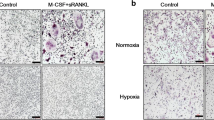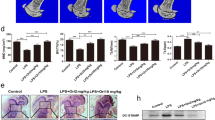Abstract
Bone is a dynamic organ, the bone-forming osteoblasts and bone-resorbing osteoclasts form the physiological basis of bone remodeling process. During pathological process of numerous inflammatory diseases, these two aspects are uncoupled and the balance is usually tipped in favor of bone destruction. Evidence suggests that the inflammatory destruction of bone is mainly attributed to oxidative stress and is closely related to mitochondrial dysfunction. The mechanisms underlying osteogenic dysfunction in inflammation still need further investigation. Reactive oxygen species (ROS) is associated with mitochondrial dysfunction and cellular damage. Here, we reported an unexplored role of cyclophilin D (CypD), the major modulator of mitochondrial permeability transition pore (mPTP), and the CypD-mPTP axis in inflammation-induced mitochondrial dysfunction and bone damage. And the protective effects of knocking down CypD by siRNA interference or the addition of cyclosporin A (CsA), an inhibitor of CypD, were evidenced by rescued mitochondrial function and osteogenic function of osteoblast under tumor necrosis factor-α (TNF-α) treatment. These findings provide new insights into the role of CypD-mPTP-dependent mitochondrial pathway in the inflammatory bone injury. The protective effect of CsA or other moleculars affecting the mPTP formation may hold promise as a potential novel therapeutic strategy for inflammation-induced bone damage via mitochondrial pathways.




Similar content being viewed by others
References
Alam MR, Baetz D, Ovize M (2015) Cyclophilin D and myocardial ischemia-reperfusion injury: a fresh perspective. J Mol Cell Cardiol 78:80–89. https://doi.org/10.1016/j.yjmcc.2014.09.026
Anami Y, Sakamaki Y, Itoh T, Inaba Y, Nakabayashi M, Ikura T, Ito N, Yamamoto K (2015) Fine tuning of agonistic/antagonistic activity for vitamin D receptor by 22-alkyl chain length of ligands: 22S-Hexyl compound unexpectedly restored agonistic activity. Bioorg Med Chem 23:7274–7281. https://doi.org/10.1016/j.bmc.2015.10.026
Bernardi P, Di Lisa F (2015) The mitochondrial permeability transition pore: molecular nature and role as a target in cardioprotection. J Mol Cell Cardiol 78:100–106. https://doi.org/10.1016/j.yjmcc.2014.09.023
Cai WW, Zhang MH, Yu YS, Cai JH (2013) Treatment with hydrogen molecule alleviates TNF alpha-induced cell injury in osteoblast. Mol Cell Biochem 373:1–9. https://doi.org/10.1007/s11010-012-1450-4
Chan DC (2006) Mitochondria: dynamic organelles in disease, aging, and development. Cell 125:1241–1252. https://doi.org/10.1016/j.cell.2006.06.010
Chinopoulos C, Starkov AA, Fiskum G (2003) Cyclosporin A-insensitive permeability transition in brain mitochondria: inhibition by 2-aminoethoxydiphenyl borate. J Biol Chem 278:27382–27389. https://doi.org/10.1074/jbc.M303808200
Clarke SJ, McStay GP, Halestrap AP (2002) Sanglifehrin A acts as a potent inhibitor of the mitochondrial permeability transition and reperfusion injury of the heart by binding to cyclophilin-D at a different site from cyclosporin A. J Biol Chem 277:34793–34799. https://doi.org/10.1074/jbc.M202191200
Collins Y, Chouchani ET, James AM, Menger KE, Cocheme HM, Murphy MP (2012) Mitochondrial redox signalling at a glance. J Cell Sci 125:801–806. https://doi.org/10.1242/jcs.098475
Du H, Guo L, Wu X, Sosunov AA, McKhann GM, Chen JX, Yan SS (2014) Cyclophilin D deficiency rescues Abeta-impaired PKA/CREB signaling and alleviates synaptic degeneration. Biochim Biophys Acta 1842:2517–2527. https://doi.org/10.1016/j.bbadis.2013.03.004
Feng D, Tang Y, Kwon H, Zong H, Hawkins M, Kitsis RN, Pessin JE (2011) High-fat diet-induced adipocyte cell death occurs through a cyclophilin D intrinsic signaling pathway independent of adipose tissue inflammation. Diabetes 60:2134–2143. https://doi.org/10.2337/db10-1411
Ginaldi L, Di Benedetto MC, De Martinis M (2005) Osteoporosis, inflammation and ageing. Immun Ageing 2:14. https://doi.org/10.1186/1742-4933-2-14
Giorgio V, Soriano ME, Basso E, Bisetto E, Lippe G, Forte MA, Bernardi P (2010) Cyclophilin D in mitochondrial pathophysiology. Biochim Biophys Acta 1797:1113–1118. https://doi.org/10.1016/j.bbabio.2009.12.006
Grcevic D, Katavic V, Lukic IK, Kovacic N, Lorenzo JA, Marusic A (2001) Cellular and molecular interactions between immune system and bone. Croat Med J 42:384–392
Halestrap AP, Woodfield KY, Connern CP (1997) Oxidative stress, thiol reagents, and membrane potential modulate the mitochondrial permeability transition by affecting nucleotide binding to the adenine nucleotide translocase. J Biol Chem 272:3346–3354
Hsu SH, Chen CT, Wei YH (2013) Inhibitory effects of hypoxia on metabolic switch and osteogenic differentiation of human mesenchymal stem cells. Stem Cells 31:2779–2788. https://doi.org/10.1002/stem.1441
Hughes G, Murphy MP, Ledgerwood EC (2005) Mitochondrial reactive oxygen species regulate the temporal activation of nuclear factor kappaB to modulate tumour necrosis factor-induced apoptosis: evidence from mitochondria-targeted antioxidants. Biochem J 389:83–89. https://doi.org/10.1042/BJ20050078
Lerner UH (2006) Inflammation-induced bone remodeling in periodontal disease and the influence of post-menopausal osteoporosis. J Dent Res 85:596–607. https://doi.org/10.1177/154405910608500704
Liao CM, Ling MP (2003) Assessment of human health risks for arsenic bioaccumulation in tilapia (Oreochromis mossambicus) and large-scale mullet (Liza macrolepis) from blackfoot disease area in Taiwan. Arch Environ Contam Toxicol 45:264–272
Nakagawa T, Shimizu S, Watanabe T, Yamaguchi O, Otsu K, Yamagata H, Inohara H, Kubo T, Tsujimoto Y (2005) Cyclophilin D-dependent mitochondrial permeability transition regulates some necrotic but not apoptotic cell death. Nature 434:652–658. https://doi.org/10.1038/nature03317
Osta B, Benedetti G, Miossec P (2014) Classical and paradoxical effects of TNF-alpha on bone homeostasis. Front Immunol 5:48. https://doi.org/10.3389/fimmu.2014.00048
Rao VK, Carlson EA, Yan SS (2014) Mitochondrial permeability transition pore is a potential drug target for neurodegeneration. Biochim Biophys Acta 1842:1267–1272. https://doi.org/10.1016/j.bbadis.2013.09.003
Reuter S, Gupta SC, Chaturvedi MM, Aggarwal BB (2010) Oxidative stress, inflammation, and cancer: how are they linked? Free Radic Biol Med 49:1603–1616. https://doi.org/10.1016/j.freeradbiomed.2010.09.006
Sanz A (2016) Mitochondrial reactive oxygen species: do they extend or shorten animal lifespan? Biochim Biophys Acta 1857:1116–1126. https://doi.org/10.1016/j.bbabio.2016.03.018
Schinzel AC, Takeuchi O, Huang Z, Fisher JK, Zhou Z, Rubens J, Hetz C, Danial NN, Moskowitz MA, Korsmeyer SJ (2005) Cyclophilin D is a component of mitochondrial permeability transition and mediates neuronal cell death after focal cerebral ischemia. Proc Natl Acad Sci U S A 102:12005–12010. https://doi.org/10.1073/pnas.0505294102
Sena LA, Chandel NS (2012) Physiological roles of mitochondrial reactive oxygen species. Mol Cell 48:158–167. https://doi.org/10.1016/j.molcel.2012.09.025
Shum LC, White NS, Nadtochiy SM, Bentley KL, Brookes PS, Jonason JH, Eliseev RA (2016) Cyclophilin D knock-out mice show enhanced resistance to osteoporosis and to metabolic changes observed in aging bone. PLoS One 11:e0155709. https://doi.org/10.1371/journal.pone.0155709
Takei H, Pioletti DP, Kwon SY, Sung KL (2000) Combined effect of titanium particles and TNF-alpha on the production of IL-6 by osteoblast-like cells. J Biomed Mater Res 52:382–387
Xu ZS, Wang XY, Xiao DM, Hu LF, Lu M, Wu ZY, Bian JS (2011) Hydrogen sulfide protects MC3T3-E1 osteoblastic cells against H2O2-induced oxidative damage-implications for the treatment of osteoporosis. Free Radic Biol Med 50:1314–1323. https://doi.org/10.1016/j.freeradbiomed.2011.02.016
Zenke G, Strittmatter U, Fuchs S, Quesniaux VF, Brinkmann V, Schuler W, Zurini M, Enz A, Billich A, Sanglier JJ, Fehr T (2001) Sanglifehrin A, a novel cyclophilin-binding compound showing immunosuppressive activity with a new mechanism of action. J Immunol 166:7165–7171
Zhen YF, Wang GD, Zhu LQ, Tan SP, Zhang FY, Zhou XZ, Wang XD (2014) P53 dependent mitochondrial permeability transition pore opening is required for dexamethasone-induced death of osteoblasts. J Cell Physiol 229:1475–1483. https://doi.org/10.1002/jcp.24589
Zorov DB, Filburn CR, Klotz LO, Zweier JL, Sollott SJ (2000) Reactive oxygen species (ROS)-induced ROS release: a new phenomenon accompanying induction of the mitochondrial permeability transition in cardiac myocytes. J Exp Med 192:1001–1014
Funding
This study was sponsored by a grant from the National Key Research and Development Program of China (2016YFC1102704), the National Natural Science Foundation of China (no.81400483), and Sichuan Province Science and Technology Innovation Team Program (2011JTD0006).
Author information
Authors and Affiliations
Corresponding author
Ethics declarations
Conflict of interest
The authors declare that they have no conflict of interest.
Rights and permissions
About this article
Cite this article
Gan, X., Zhang, L., Liu, B. et al. CypD-mPTP axis regulates mitochondrial functions contributing to osteogenic dysfunction of MC3T3-E1 cells in inflammation. J Physiol Biochem 74, 395–402 (2018). https://doi.org/10.1007/s13105-018-0627-z
Received:
Accepted:
Published:
Issue Date:
DOI: https://doi.org/10.1007/s13105-018-0627-z




